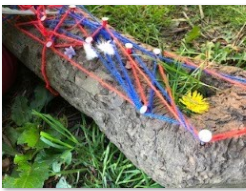Nature Pedagogy
What is it?
Nature pedagogy has no age limits, and a sense of being one with nature transcends curriculum levels.
The key benefits of a nature-based learning approach are listed as:
- Increased self-esteem and confidence
- Helping to develop social skills, language and communication skills
- Building confidence in problem-solving, motivation for learning and expanding knowledge
- Improved physical health including fine and gross motor skills
- Promoting curiosity, team building, perseverance and resilience
(Adapted from O’Brien, 2009, p. 50; Realising the Ambition, Education Scotland, 2020, p. 105)
“Nature Pedagogy, the art of being with nature, inside, outside and beyond.”
(Nature Pedagogy: A common thread connecting nature-based settings worldwide, Natural start alliance, Claire Warden, 2018)
Froebel saw nature as the ultimate teacher stating, ‘people are ‘part of’ not separate from ‘the natural world.’
(The Education of Man, Froebel, 1887)
Cree and Robb (2021) believe, “We need a new paradigm (a pattern or model) where nature is part and parcel of our education and health systems, providing ‘human wholeness’ and ecological responsibility.”
(The Essential Guide to Forest School and Nature Pedagogy, Cree and Robb, 2021, p. 367)
Nature pedagogy is not restricted to outdoor nurseries, nature kindergartens or forest schools. McQuarrie et al. (2013) noted in Realising the Ambition (Education Scotland, p. 105), “local contexts exert an influence not only on the pedagogy and practice within each but on children’s play and learning experiences.”
Key messages:
“Nature Pedagogy reframes nature as a teaching influence in its own right.
This approach isn’t just about spending times outside-it’s about building a relationship with nature.”
(Nature Pedagogy | Mindstretchers Academy)
“The best classroom and the richest cupboard is roofed only by the sky.”
(Margaret McMillan, 1925)
- Settings utilise the abundance of nature’s resources to enable the indoor, outdoor, and beyond the gate environments to offer high-quality provision for children.
- Practitioners create opportunities and a motivational shift for all (children and practitioners together) to get outside to wonder and benefit from shared nature-based experiences.
Ways we can do this:
The Role of the Adult in Nature-Based Inquiry
“In Nature Pedagogy, the adult is not the deliverer of content—but a co-researcher, a listener, and a guide.
They move alongside the child, helping to nurture curiosity and co-construct meaning from the world around them.
Rather than planning everything in advance, the adult’s role is to observe closely, listen deeply, and respond with intention.
But that doesn’t mean stepping back entirely.
This approach is all about knowing when to step in, and when to hold space.
When to offer a provocation, and when to simply say: “I wonder…”
The adult also curates the learning environment—selecting natural materials that invite exploration, and shaping outdoor spaces that support both risk and inquiry.
They ensure the day allows for long, uninterrupted periods of time in nature, where thinking and wondering can unfold at a child’s pace.
Ultimately, the role of the adult in Nature Pedagogy is a relational one.
It requires us to trust children as capable learners, to trust nature as a powerful co-educator, and to trust ourselves—to notice, reflect, and act with purpose.”
Nature Pedagogy | Mindstretchers Academy
Realise the potential of nature to offer children infinite lines of inquiry that are as broad as they are deep, from the gravel, soil, and plants on our doorstep to outdoor, garden spaces and beyond the gate, to wider and potentially wilder areas of coastline, river courses, and woodlands.
Use nature-based provocations where adult intent can initiate open-ended lines of inquiry and support pedagogy.
Evidence and track pedagogy through Floorbooks, learning journeys (digital or paper), communication books, or memory booklets.
Look to nature first when planning and resourcing your outdoors. What has the weather offered you? Puddles from rain, frost patterns, icicles, snow to dig and shape, or shadows, can you catch your shadow?
“Sunshine is delicious, rain is refreshing, wind braces us up, snow is exhilarating: there is really no such thing as bad weather, only different kinds of good weather.”
(John Rushkin, 1889)
What is the play affordance of nature’s resources, for example, sticks? To bend into bows, add a string for fishing rods, tie leaves on for brooms, whittle, wrap with wool or ribbons. The possibilities are endless.
Can you reflect, wonder and make connections to nature indoors, ice lanterns, shadow puppets and plays, mark-making with charcoal, inks made from berries, fruits grown for a snack, or cooking.
Practitioners can create a sense of wonder by posing questions that lead to an investigation. What creatures are there in the garden, big and small? What evidence is left (holes in leaves, feathers, footprints)? Have magnifying glasses at the ready and detailed identification kits to extend children’s language with nature pedagogy; bee, bumblebee, white-tailed bumblebee. Feathers can be compared, matched or sorted by size, colour and pattern.
Display children’s treasures of nature, indoors and or outside; for example, feathers found outdoors are saved in a treasure log.

Open-ended walks beyond the gate are planned by the children who are involved in the organisation. Ask them what they will need to take? Allow the children to risk-assess. Do we need something to collect treasures in? Do we need a notepad for records, a measuring tape, a subitising cape?
Nature books within library collections and are available outside.
Seasonal resource banks with images, films, artefacts are available for the practitioners and children.
Linked Areas of Practice
Creativity
Curriculum
Learning Environment
Play
Play Pedagogy
Risky Play
Science, Technology, Engineering & Maths (STEM)
Spaces
Sustainability
Tools
Reflecting on Practice
SBC Guidance to support
National Guidance to support
Further Reading to support
Training to support
